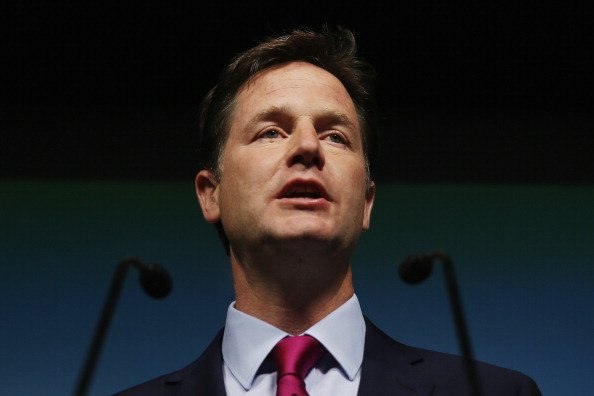The time has come to look at how the Liberal Democrat's prospects might affect Labour and Tory fortunes in the 2015 general election
Following the recent events commemorating D-Day, the next big anniversary will mark VE day, on Friday May 8 next year. That is also when we shall know how many MPs each party will have in the next parliament. It will be Victory in Election day, not just Victory in Europe day. But which party leader, or leaders, will be triumphant, and which will be forced to surrender?
Much has been written, here and elsewhere, about the impact of UKIP on the result – whether Nigel Farage’s party will retain enough votes to cost the Conservatives enough marginal seats to drive David Cameron from office. The time has come to look at another corner of the electoral battleground. Following the dismal performance of the Liberal Democrats in the local and European elections, what are their prospects – not just in terms of how many Lib Dem MPs survive, but how their vote might affect Labour and Tory fortunes?
Want to receive Peter Kellner's commentaries by email? Subscribe here
Until the recent elections I assumed that the Lib Dems would regain some ground as next year’s election approached. Even if they remained well below the 24% they scored in 2010, most of their MPs would enjoy enough local support to minimise their losses.
Now I am not so sure. That is, I still think that the Lib Dems could claw their way back to around 14%; but there is now a chance that they will remain stuck on around 8%, where YouGov’s tracking polls have put them for the past few weeks. Some Lib Dem MPs may well suffer below-average vote losses, but still be swept away by the tide running against them.
To explore what could happen, the following table provides some numbers for six scenarios – three involving the Lib Dems stuck on 8% of the popular vote, the other three with them recovering to 14%. On the face of it, a Lib Dem meltdown should be great news for the Conservatives: they are the second-place challengers in 38 seats, while Labour came second last time in just 16. And to some extent, the Tories would benefit; but the full impact could be more complex.
For each scenario, I show two seat calculations. In each case, the ‘uniform swing’ figures show what would happen if the percentage movement of votes were the same in every constituency. I have used the calculator provided by my colleague Anthony Wells’ Polling Report website.
The ‘adjusted’ figures show my best guesses of what would actually happen with these voting percentages. They vary from the ‘uniform swing’ figures in two ways. First, I assume that the personal following of Lib Dem MPs will help the party to retain eight seats it would otherwise lose – five to the Conservatives and three to Labour. Second, I assume that first-time Tory MPs will benefit from a ‘sophomore surge’ – just as Labour MPs elected for the first time in 1997 held more seats in 2001 than would have been expected on the national 2% swing to the Conservatives. (For a discussion of this phenomenon, see my blog earlier this year here). For the purposes of this analysis, I assume this is worth 18 seats to the Tories – seats they would lose on a uniform swing but in practice keep.
The combined effect of these two adjustments is to add 13 seats net to the Conservative tally and 8 to the Lib Dems, and cost Labour 21 seats. (I assume that UKIP will subside to around 10% and not have any MPs in the new Parliament.)
| Lib Dem Meltdown | Lib Dem Recovery | |||||
|---|---|---|---|---|---|---|
Vote % | Uniform swing seats | Adjusted Seats | Vote % | Uniform Swing Seats | Adjusted Seats | |
2% Con Lead |
| |||||
Con | 38 | 300 | 313 | 35 | 286 | 299 |
Lab | 36 | 313 | 292 | 33 | 305 | 284 |
LD | 8 | 11 | 19 | 14 | 31 | 39 |
Others | 18 | 26 | 26 | 26 | 28 | 28 |
Con, Lab Level | ||||||
Con | 37 | 289 | 302 | 34 | 272 | 285 |
Lab | 37 | 324 | 303 | 34 | 316 | 295 |
LD | 8 | 11 | 19 | 14 | 34 | 42 |
Others | 18 | 26 | 26 | 18 | 18 | 28 |
2% Lab Lead |
| |||||
Con | 36 | 275 | 288 | 33 | 259 | 272 |
Lab | 38 | 334 | 313 | 35 | 328 | 307 |
LD | 8 | 15 | 23 | 14 | 36 | 44 |
Others | 18 | 26 | 26 | 18 | 27 | 27 |
Three clear conclusions emerge:
1. The geographical bias in Labour’s favour largely disappears. Suppose both Labour and the Conservatives win the same number of votes. On a uniform swing, Labour would have either 35 more MPs (in the case of a Lib Dem meltdown) or 44 (Lib Dem recovery). But the adjusted figures reduce Labour’s lead to one (meltdown) or ten (recovery).
2. Labour must also abandon its hopes of winning an overall majority with a narrow lead in the popular vote. Depending on Lib Dem performance and the precise size of the Tories’ sophomore surge, Labour’s lead needs to be at least 3% and possibly 5%.
3. Conversely, the Tories could win enough seats to govern alone with a lead in the popular vote of just 2% (Lib Dem meltdown) or 4% (Lib Dem recovery). Such leads would not give the Conservatives the 326 seats they need for an overall majority, but enough to exceed the combined total of Labour and Lib Dems seats – the minimum that they will probably need to run a one-party minority government, at least for a while. (For those interested in the minutiae of these things, I assume that Northern Ireland’s 8-9 Democratic Unionists would support a minority Tory government in a confidence vote, while the Green, Scottish National and Plaid Cymru MPs would not.)
I would add a fourth conclusion, though this is more speculative. Let’s suppose Labour and the Tories enter next year’s election campaign level-pegging on 37% each, with the Lib Dems languishing on 8%. Then, on my adjusted figures, the contest to be the largest party will be too close to call.
If the Lib Dems then pick up support, as they have so often done so in the past, the it looks as if Labour would then open up a ten-seat lead (295-285) over the Tories. But that assumes that the Lib Dems’ campaign gains would be equally at the expense of both main parties. However, we know that the Lib Dems have lost far more votes to Labour than to the Tories since 2010. Given this, any Lib Dems' campaign gains may well consist of more Labour than Tory post-2010 converts returning home. Suppose that that the six point increase in Lib Dem support causes the Tories to lose two points and Labour four. In that event, the Tories (with 299 MPs), not Labour (with 284), would end up as the largest party in the new House of Commons.
These are all illustrations of what might happen: the permutations of voting percentages, campaign effects and possible adjustments to uniform swing, are endless. No pollster, party strategist or politics nerd should rely on the mechanical application of any particular formula. The tables in this blog simply show my best guesses. Other factors may affect the outcome. For example, the differential impact of ground-war campaigning in marginal seats made a difference in 2010 and may do so again. And, of course, the precise effect of a Lib Dem meltdown will depend, seat by seat, on where its lost voters end up.
But if my adjustments should be treated with caution, so should figures generated by uniform swing calculators. In particular, Labour would be unwise to assume that they can win more seats than the Tories with fewer votes. To be certain of leading the largest contingent of MPs in the next parliament, Ed Miliband needs his party to win the popular vote.
Image: Getty










